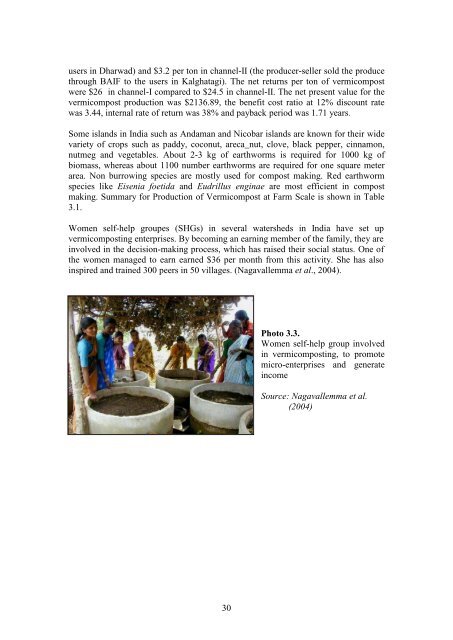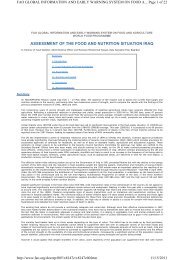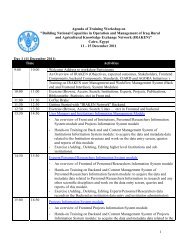Vermiculture in Egypt: - FAO - Regional Office for the Near East and
Vermiculture in Egypt: - FAO - Regional Office for the Near East and
Vermiculture in Egypt: - FAO - Regional Office for the Near East and
Create successful ePaper yourself
Turn your PDF publications into a flip-book with our unique Google optimized e-Paper software.
users <strong>in</strong> Dharwad) <strong>and</strong> $3.2 per ton <strong>in</strong> channel-II (<strong>the</strong> producer-seller sold <strong>the</strong> produce<br />
through BAIF to <strong>the</strong> users <strong>in</strong> Kalghatagi). The net returns per ton of vermicompost<br />
were $26 <strong>in</strong> channel-I compared to $24.5 <strong>in</strong> channel-II. The net present value <strong>for</strong> <strong>the</strong><br />
vermicompost production was $2136.89, <strong>the</strong> benefit cost ratio at 12% discount rate<br />
was 3.44, <strong>in</strong>ternal rate of return was 38% <strong>and</strong> payback period was 1.71 years.<br />
Some isl<strong>and</strong>s <strong>in</strong> India such as Andaman <strong>and</strong> Nicobar isl<strong>and</strong>s are known <strong>for</strong> <strong>the</strong>ir wide<br />
variety of crops such as paddy, coconut, areca_nut, clove, black pepper, c<strong>in</strong>namon,<br />
nutmeg <strong>and</strong> vegetables. About 2-3 kg of earthworms is required <strong>for</strong> 1000 kg of<br />
biomass, whereas about 1100 number earthworms are required <strong>for</strong> one square meter<br />
area. Non burrow<strong>in</strong>g species are mostly used <strong>for</strong> compost mak<strong>in</strong>g. Red earthworm<br />
species like Eisenia foetida <strong>and</strong> Eudrillus eng<strong>in</strong>ae are most efficient <strong>in</strong> compost<br />
mak<strong>in</strong>g. Summary <strong>for</strong> Production of Vermicompost at Farm Scale is shown <strong>in</strong> Table<br />
3.1.<br />
Women self-help groupes (SHGs) <strong>in</strong> several watersheds <strong>in</strong> India have set up<br />
vermicompost<strong>in</strong>g enterprises. By becom<strong>in</strong>g an earn<strong>in</strong>g member of <strong>the</strong> family, <strong>the</strong>y are<br />
<strong>in</strong>volved <strong>in</strong> <strong>the</strong> decision-mak<strong>in</strong>g process, which has raised <strong>the</strong>ir social status. One of<br />
<strong>the</strong> women managed to earn earned $36 per month from this activity. She has also<br />
<strong>in</strong>spired <strong>and</strong> tra<strong>in</strong>ed 300 peers <strong>in</strong> 50 villages. (Nagavallemma et al., 2004).<br />
30<br />
Photo 3.3.<br />
Women self-help group <strong>in</strong>volved<br />
<strong>in</strong> vermicompost<strong>in</strong>g, to promote<br />
micro-enterprises <strong>and</strong> generate<br />
<strong>in</strong>come<br />
Source: Nagavallemma et al.<br />
(2004)





